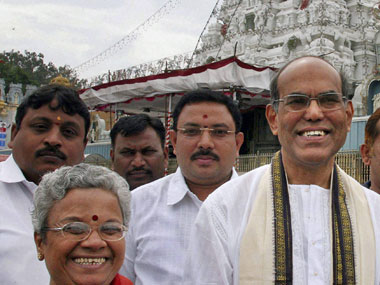Tighter than expected liquidity conditions will force the Reserve Bank of India to cut CRR (cash reserve ratio) even before the third quarter policy review scheduled for 24 January 2012.
Duvvuri Subbarao, the RBI Governor, is likely to cut the CRR by 50 bps (basis points, where 100 bps make 1 percent) in the first fortnight of January 2012 as tight liquidity conditions push up yields at the short end of the curve as banks scramble for money. A 50 bps CRR cut will release over Rs 25,000 crore in the system and alleviate liquidity concerns.
Liquidity has tightened considerably over the last couple of months. Liquidity as measured by bids for repo at 8.5 percent in the LAF (liquidity adjustment facility) auction of the RBI averaged Rs 167,000 crore on a daily basis as of week ended 23 December 2011. Bids for repo - the rate at which the RBI lends to banks - averaged around Rs 60,000 crore in the third week of October 2011. Bids touched an all-time high of Rs 173,000 crore on 23 October.
[caption id=“attachment_165363” align=“alignleft” width=“380” caption=“Subbarao, the RBI Governor, is likely to cut the CRR by 50 bps in the first fortnight of January as tight liquidity conditions push up yields at the short end of the curve as banks scramble for money. PTI”]
 [/caption]
[/caption]
One of the reasons for the sharp rise in the liquidity deficit was the advance tax money going out of the system. Advance tax of over Rs 50,000 crore went into the government’s coffers in the week to 17 December, causing a liquidity strain. The government used Rs 34,000 crore of this money to pay off the overdraft taken from the RBI and even if the government spends the rest of the advance tax money in the first week of January 2012, system liquidity will still be hugely negative.
Assuming that government spends Rs 20,000 crore in the first week of January 2012, bids for repo will come down to levels of Rs 130,000-Rs 140,000 crore, much above the RBI’s comfort levels of Rs 60,000 crore.
The RBI has been intervening in the currency markets to support a falling rupee (INR). The threat of the INR falling further from all-time lows of Rs 54 to dollar (USD) made the central bank sell the dollar to prevent a free fall. When the RBI sells dollars, it sucks liquidity out of the system. This forces banks to access the LAF (liquidity adjustment facility) window for funds.
On a more fundamental note, the weak growth in bank deposits at 7.2 percent in the fiscal year to date is a worry for liquidity. Deposits have to grow at least 18 percent to counter the structural liquidity issues facing the country.
The stress in banking system liquidity is seen in the fact that banks are rushing to garner non-resident Indian (NRI) deposits by raising US dollar deposit rates by 500 bps to 600 bps after the interest rate deregulation by the RBI. Banks’ borrowing costs in the CD (certificates of deposit) market is also going up with three-month CD rates up by 100 bps over the last one month. Banks have also upped savings account rates by 300 bps and above to get in fresh liquidity.
The RBI has bought Rs 33,000 crore of government bonds through OMO (open market operation) auctions over the last one month. Adding primary liquidity to the market through bond purchases will help liquidity but it is not enough to bring in a sharp rise in systemic liquidity.
The RBI has allowed banks to dip into their SLR (statutory liquidity ratios) by 1 percent to borrow funds from the MSF (marginal standing facility) window. The cost of borrowing through the MSF window is 9.5 percent (1 percent above the repo rate) and if banks do borrow from the MSF window it will increase the cost of funds sharply for banks.
Overnight money market rates have increased sharply over the last one week. Call money rates have gone up from 8.5 percent levels to 9.8 percent levels on the back of tight system liquidity. Overnight rates are expected to go higher as liquidity remains tight in the system.
The RBI will have to use additional liquidity tools to ease system liquidity to more comfortable levels. Given that the central bank has sounded its intention of easing its policy stance down the line, a CRR cut will not be taken as an out-of-turn measure by the markets.
The bond markets are anticipating a CRR cut soon given that government bond yields are trading at three-month lows despite tight liquidity conditions. Ten-year benchmark bond yields closed at 8.38 percent levels on 23 December 2011, down 50 bps from highs seen in November 2011. Bond traders are willing to take a negative carry (difference between call money rates at 9.8 percent and bond yields at 8.4 percent) in anticipation of a further drop in yields post a CRR cut.
The interest rate swap markets, too, are anticipating a CRR cut with five-year OIS (overnight index swap) yields at 7 percent levels. The OIS floating rate benchmark is the call money setting rate, or the Mibor (Mumbai interbank offer rate) and traders are willing to take a negative carry of around 280 bps in running long positions on the OIS in anticipation of rate cuts.
Arjun Parthasarathy is the Editor of www.investorsareidiots.com , a web site for investors.
Arjun Parthasarathy has spent 20 years in the financial markets, having worked with Indian and multinational organisations. His last job was as head of fixed income at a mutual fund. An MBA from the University of Hull, he has managed portfolios independently and is currently the editor of www.investorsareidiots.com </a>. The website is for investors who want to invest in the right financial products at the right time.
)